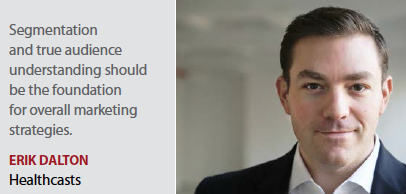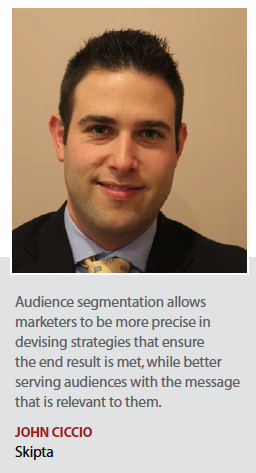 For many marketers today, audience segmentation is becoming a key strategic activity when conducting audience analysis. At the most basic level, audience segmentation is the process of dividing a large group of people into homogeneous subgroups — or segments — based upon those who have similar needs or on defined criterion such as product usage, demographics, psychographics, communication behaviors, and media use.
For many marketers today, audience segmentation is becoming a key strategic activity when conducting audience analysis. At the most basic level, audience segmentation is the process of dividing a large group of people into homogeneous subgroups — or segments — based upon those who have similar needs or on defined criterion such as product usage, demographics, psychographics, communication behaviors, and media use.
The reason for segmenting audiences is that it allows marketers to match programs and messages to the audience members who are the most critical to reach, thereby helping each audience to adopt new behaviors.
John Ciccio, president of Skipta, says audience segmentation allows marketers to be more precise in devising strategies that ensure the end result is met, while better serving audiences with the message that is relevant to them.
At the same time, Johanna Skilling, executive VP, director of planning, US Ogilvy CommonHealth Worldwide, warns marketers and clients that not all segments are created equal.
“Increasingly, we are able to create segments informed by a wide range of diverse insights — emotional, attitudinal, and behavioral — both in the analogue and virtual worlds, even biometric," she says. “This means we can be more informed and specific about the types of customers or prospects that offer the greatest volume and efficiency opportunities. Ultimately, data-driven marketing will help all marketers join the long-tail movement, in which long-term sales and revenue are driven by individual interactions. This will help us realize the vision of 1:1 marketing across vast target audiences."
 Ashik Desai, executive VP, business growth and analytics, at ContextMedia Health, agrees that while audience segmentation is mission critical, it’s just a starting point.
Ashik Desai, executive VP, business growth and analytics, at ContextMedia Health, agrees that while audience segmentation is mission critical, it’s just a starting point.
“The overall success of a marketing strategy is also dependent on the creative, the execution of the creative, and the follow up with the audience," he says.
“Delivery based on different demographic variables of patients, including ethnicity, age, gender, socio-economic levels, etc., drives some of the deepest engagement rates in digital health education. The perfect audience segment means nothing if a marketer can’t connect with those individuals and influence behavior."
Experts agree that audience segmentation is just one small, but very important part of a marketing strategy.
“And, it should be the first step," says Erik Dalton, executive VP, Healthcasts. “Deep insights on these segments then need to be uncovered and once those insights are available, the real work begins to create relevant messaging that will resonate with those unique segments. Segmentation and true audience understanding should be the foundation for overall marketing strategies."
 The challenge with audience segmentation is that it can be resource intensive, from a personnel standpoint as well as financially, so it’s important to first determine, according to many experts, if a personalized message strategy is appropriate.
The challenge with audience segmentation is that it can be resource intensive, from a personnel standpoint as well as financially, so it’s important to first determine, according to many experts, if a personalized message strategy is appropriate.
Ms. Skilling says the two most tangible factors in determining whether a personalized message strategy is appropriate are return on investment or ROI and lifetime value or LTV.
The questions Ms. Skilling encourages her teams to ask are: how much investment is required to create a personalized marketing universe and how long will it take to pay off?
“A number of large pharmaceutical marketers are actively working on addressing these questions on the corporate and brand levels," she says. “Some quicker solutions involve apps combined with medical devices, which offer the opportunity to prove the value of personalized interactions based on individual data inputs. The vision these marketers share is development of a robust set of data-based profiles of individual patients and HCPs, which will create actionable opportunities to cross-sell healthcare products and services based on specific needs and interests, similar to how Amazon uses our data to understand whether we want, or need, a specific item based on our history and other data points. Pharmaceutical marketers who want to create this level of personalization will need to determine whether they prefer the efficiency of partnering with a third-party, cloud-based data management company, or the in-depth customization available through proprietary data capture and analytics systems."
 Mr. Dalton believes when it comes to pharma marketing, especially with the transition from a broad portfolio of drugs marketed to primary care physicians to a smaller subset of medications targeted to niche groups of specialists and patient groups, a personalized message strategy is nearly always appropriate.
Mr. Dalton believes when it comes to pharma marketing, especially with the transition from a broad portfolio of drugs marketed to primary care physicians to a smaller subset of medications targeted to niche groups of specialists and patient groups, a personalized message strategy is nearly always appropriate.
“A place still remains for broad reach awareness tactics, especially when considering where the product is in its lifecycle, but in nearly all of those instances a targeted and personalized outreach plan will enhance efforts," he says.
Determining how appropriate a personalized message is boils down to approaching messaging with a deep empathy for the audience, Mr. Desai says.
“Our primary goal — 100% of the time — is to improve patient outcomes," he says. “Empathy is at the heart of this. For example, in sensitive verticals such as infectious disease or oncology, there are select instances where a personalized message might make the audience uncomfortable or alienated. In instances like these, it’s important to create a sense of community among the audience. The intention isn’t trying to reach a patient as an individual; we want to try to communicate that they are not alone."
Benefits of Custom Fitting Messages to Specific Audiences
As the shift from consumption of content pushed to selection of content pulled or actively searched for continues, marketers’ skills will be tested to make sure the content they develop is even more relevant and engaging to those specific audiences.
“By providing only the information customers are actively seeking, based on prior knowledge of their needs and preferences, marketers can ensure the highest levels of engagement with the content and the highest propensity for action," Mr. Dalton says. “But beyond simply providing custom messages to target segments, it is imperative to continuously gauge audience feedback to the content provided — beyond clicks and opens. Listening to customers will help further refine segmentation and content creation strategies along the way. This feedback loop begins the process of a two-way dialogue with the target audience."
Mr. Ciccio says tailoring and curating the message or offer substantially increases receptivity and engagement, which will lead to improved brand awareness and deeper loyalty.
“Within life-sciences marketing, we’ve all sat in front of the TV at night, and saw an ad about a treatment that had nothing to do with us," Mr. Desai says.
“From a marketer’s perspective, this is not a successful impression. Custom fitting no longer just means customizing the copy of a messaging, it means delivering the messaging in the right context, in the exact moments when the target audience is making a decision about their health. We refer to these as resolution moments, and they are very high impact."
Challenges with Audience Segmentation
 All marketing strategies today in a multi-stakeholder ecosystem have challenges, but when it comes to audience segmentation, the diversity of audiences makes message creation and delivery even more complex.
All marketing strategies today in a multi-stakeholder ecosystem have challenges, but when it comes to audience segmentation, the diversity of audiences makes message creation and delivery even more complex.
“Becoming too tailored could be a missed opportunity if the message is so granular that it becomes diluted," Mr. Ciccio says.
Ms. Skilling says to mitigate unforeseen obstacles it’s important to segment the target audience with specific objectives in mind.
“The goal is always to identify actionable audience segments: groups who share specific needs or behaviors that we can address, manage, and influence," she says. “It can be very tempting to investigate every possible characteristic that could lead to a segmentation profile, but that can lead us down a very deep rabbit hole. It’s often far more efficient to start with desired behaviors, and reverse segment based on drivers and barriers, which are validated, of course, by real-life behaviors that are monitored and measured on a continuous basis."
Another challenge is the old chestnut of ROI and finding the right metrics to make sure the measurement is not only accurate but is appropriate for the strategy.
For example, Mr. Desai says in his experience one challenge with audience segmentation and targeting is finding creative ways to measure success that does not come directly from the audience being targeted.
“For instance, a TV ad that airs during football may have nothing to do directly with the target patient, but it could very well impact a loved one, which might be enough for them to bring up the message to the patient, which could ultimately impact his or her decision," he says. “Solving this problem is less than perfect, but marketers must commit to measure it."
Mr. Ciccio says there are platforms that can clearly measure impact based on behavior following receipt of the message, such as prescribing activity.
“And when used in tandem with the new innovations, success can be measured in exciting ways," Mr. Desai says. “Whether it’s the lift in scripts by office, impressions, or time patients spent engaging with the messaging, there are many ways to accurately measure success. Life-science marketers must be exhaustive in measuring this ROI, regardless of what metric is defined as most critical."
Ms. Skilling says a clear ROI is always available when marketing is developed with a measurement plan in mind, and executed with all the appropriate triggers and interactions that lead to accurate metrics.
“But if we want to know whether segmentation can lead to a positive ROI, we have to look at available or required investment versus expected revenue," she says. “On a low-margin product like toothpaste, it’s more challenging to imagine how segmentation and personalization could drive enough revenue to justify the investment required. But it would also be wonderful to see someone succeed. It’s easier to point to examples of higher-margin products, including some pharmaceutical products, which benefit from the greater impact associated with more personalized marketing, driven by insights that define specific segments."
Technology advancements now allow marketers to both measure and segment an audience with incredible accuracy.
“Within the point-of-care, the foundation of these technologies lies in the incredible amount of data and analytics that are now available," Mr. Desai says. “We can get an understanding of how frequently patients are visiting their physician, how much they adhere to treatments, and how they go about making decisions about their healthcare. We can break this down not only by geography, but also by specialty. These data make it possible to segment an audience with incredible specificity, and more importantly, deliver hyper-focused messaging in a meaningful way."
For Ms. Skilling, the vision of one-to-one marketing has been made real by technology, and that’s throwing traditional notions of segmentation on its head.
“The acceleration of technological development — from flexible sensors to apps that can deliver biometrics to a central platform 24/7 — combined with sophisticated data capture and analytics, is allowing marketers to use individual, behavior-generated metrics to create more accurate, relevant, and actionable target segmentation," she says. “The practice of creating predefined market segments is fast becoming obsolete, replaced by what we’re calling the ‘N of 1’ model. The combination of cloud-based technology and powerful data analysis allows us to understand, reach, and engage HCPs on an individual level and develop hypotheses of behavioral segments that can be tested against specific business objectives."
Segmentation is also being driven by technology-enabled experiences that go far beyond marketing, content, and product interactions. For example, Ms. Skilling notes Medopad, a British health-tech provider, which is giving cancer patients the power to monitor and report the effects of chemotherapy in real time, via an Apple Watch app. The app helps improve each patient’s experience, while generating data sets that can identify and understand groups of patients who react to the drugs in different ways.
“The technology itself can open up new market opportunities," she says. “For example, the Kenzen smart patch is a flexible wearable that sits on the skin to monitor heart rate, respiration, temperature, and sweat signals tied to an app that ensures the user drinks enough water to stay hydrated. On first glance, it looks like a product for athletes. The benefits of the technology, however, drove the company to identify an entirely unexpected target group: companies with workers who are exposed to extreme heat, whether due to working conditions or geography. This allows employers to help reduce healthcare risks among these employees."
Another challenge is that there is no one-size-fits-all delivery system in an era where content can and is consumed anywhere at any time.
 “The key is finding the right mix of content and platform and providing it across all portals at the right frequency," Mr. Dalton says. “With appropriate analysis of audience segments, marketers will know if they are providing the right content, when the audience needs it, by noting levels of engagement."
“The key is finding the right mix of content and platform and providing it across all portals at the right frequency," Mr. Dalton says. “With appropriate analysis of audience segments, marketers will know if they are providing the right content, when the audience needs it, by noting levels of engagement."
Mr. Ciccio says the ideal delivery portal will vary along with the personalized message and the preferences of the audience.
“Just as the message should be tailored, so too should the delivery mechanism," he says.
Ideally, the intention would be to deliver personalized messages through more than one portal. Mr. Desai says think of it as messaging vis a vie surround-sound.
“Instead of having all of the output from a single source, we want to communicate a comprehensive message across multiple platforms," he says.
“Additionally, we want to reach the audience how they want to be reached. For example, by providing patients with information that they want on a platform that is native to them — their personal mobile device — marketers can reach them on a device that they are already comfortable with. This can build an inherent trust."
Ms. Skilling agrees that a robust portal for personalized content works best when there’s a well-established relationship.
“American Express has decades of experience offering highly personalized content to card members, and we’ve all become accustomed to personalized offers and content driven by the data we provide — either overtly or through our behaviors — to companies from OpenTable to TripAdvisor to Amazon.com," she says. “And yet none of these companies limit their personalized messages to a portal. For pharmaceutical marketers, some best practices include engaging loyal customers at the times and in the places they are most likely to be responsive."
Since neither consumers nor HCPs are in the habit of going to brand portals for pharmaceutical products or medical devices, it is this wider universe of media choices that gives marketers the opportunity to engage their patients and HCPs, using a more personalized, individualized approach, Ms. Skilling concludes. (PV)


















